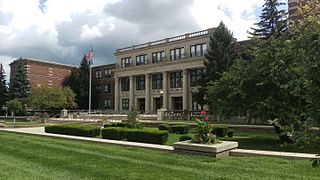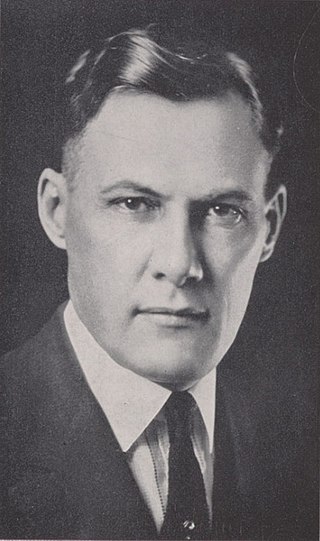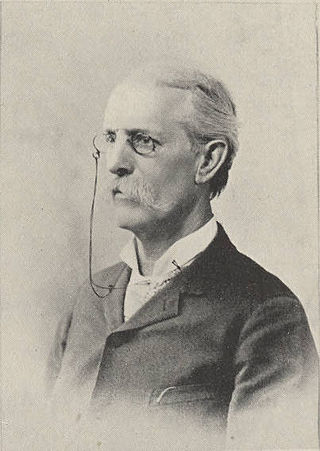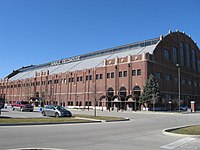John Morton-Finney was an American civil rights activist, lawyer, and educator who earned eleven academic degrees, including five law degrees. He spent most of his career as an educator and lawyer after serving from 1911 to 1914 in the U.S. Army as a member of the 24th Infantry Regiment, better known as the Buffalo soldiers, and with the American Expeditionary Forces in France during World War I. Morton-Finney taught languages at Fisk University in Tennessee and at Lincoln University in Missouri, before moving to Indianapolis, Indiana, where he taught in the Indianapolis Public Schools for forty-seven years. Morton-Finney was a member of the original faculty at Indianapolis's Crispus Attucks High School when it opened in 1927 and later became head of its foreign language department. He also taught at Shortridge High School and at other IPS schools. Morton-Finney was admitted as a member of the Bar of the Indiana Supreme Court in 1935, as a member of the Bar of the U.S. District Court in 1941, and was admitted to practice before the U.S. Supreme Court in 1972.

The University of Indianapolis (UIndy) is a private United Methodist Church-affiliated university in Indianapolis, Indiana. It offers Associate, Bachelor's, Master's, and Doctoral degrees. It was founded in 1902 as Indiana Central University and was popularly known as Indiana Central College from 1921 until 1975. In 1986 the name was changed to University of Indianapolis.

A normal school or normal college is an institution created to train teachers by educating them in the norms of pedagogy and curriculum. In the 19th century in the United States, instruction in normal schools was at the high school level, turning out primary school teachers. Many such schools are now called teacher training colleges or teachers' colleges, but in Mexico, continue to be called normal schools, with student-teachers being known as normalistas. Many schools currently require a high school diploma for entry, and may be part of a comprehensive university. Normal schools in the United States, Canada, and Argentina trained teachers for primary schools, while in Europe, the equivalent colleges typically educated teachers for primary schools and later extended their curricula to also cover secondary schools.

Butler University is a private university in Indianapolis, Indiana. Founded in 1855 and named after founder Ovid Butler, the university has over 60 major academic fields of study in six colleges: the Lacy School of Business, College of Communication, College of Education, College of Liberal Arts and Sciences, College of Pharmacy and Health Sciences, and Jordan College of the Arts. Its 295-acre (119 ha) campus is approximately five miles (8.0 km) from downtown Indianapolis.

The Indiana University School of Medicine (IUSM) is a major, multi-campus medical school located throughout the U.S. state of Indiana and is the graduate medical school of Indiana University. There are nine campuses throughout the state; the principal research, educational, and medical center is located on the Indiana University–Purdue University Indianapolis (IUPUI) campus in Indianapolis. With 1,452 MD students, 203 PhD students, and 1,356 residents and fellows in the 2022–23 academic year, IUSM is the largest medical school in the United States. The school offers many joint degree programs including an MD/PhD Medical Scientist Training Program. It has partnerships with Purdue University's Weldon School of Biomedical Engineering, other Indiana University system schools, and various in-state external institutions. It is the medical school with the largest number of graduates licensed in the United States per a 2018 Federation of State Medical Boards survey with 11,828 licensed physicians.

Marian University is a private Roman Catholic university in Indianapolis, Indiana. Founded in 1851 by the Sisters of St. Francis in Oldenburg, Indiana, the college moved to Indianapolis in 1937. Marian was known as Marian College from 1936 until 2009, when it was renamed Marian University.

The Ball brothers were five American industrialists and philanthropists who established a manufacturing business in New York and Indiana in the 1880s that was renamed the Ball Corporation in 1969. The Ball brothers' firm became a global manufacturer of plastic and metal food and beverage containers as well as a manufacturer of equipment and supplier of services to the aerospace industry. In addition to the brothers' manufacturing business, they were also noted for their philanthropy and community service. Earnings from their business ventures provided the financial resources to support a number of other projects in the community of Muncie, Indiana, and elsewhere. Most notably, the brothers became benefactors of several Muncie institutions including Ball State University, Ball Memorial Hospital, the YMCA, Ball stores department store, and Minnetrista. The Ball Brothers Foundation, established in 1926, continues the family's philanthropic interests.
The History of Ball State University predates Ball State University's public-funding era by almost two decades. Previous educational institutions operated at the intersection of University and McKinley avenues before 1918. They were neither public nor did they carry the "Ball" name.

Hinkle Fieldhouse is a basketball arena on the campus of Butler University in Indianapolis, Indiana. Completed in early 1928, it was the largest basketball arena in the United States until 1950. The facility was renamed Hinkle Fieldhouse in 1966 in honor of Butler's longtime coach and athletic director, Paul D. "Tony" Hinkle. It is the sixth-oldest college basketball arena still in use. Added to the National Register of Historic Places in 1983 and designated a U.S. National Historic Landmark in 1987, Hinkle Fieldhouse is sometimes referred to as "Indiana's Basketball Cathedral."

Peru State College (Peru) is a public college in Peru, Nebraska. It was founded by members of the Methodist Episcopal Church in 1865, making it the first and oldest institution of higher education in Nebraska.

Shortridge High School is a public high school located in Indianapolis, Indiana, United States. Shortridge is the home of the International Baccalaureate and arts and humanities programs of the Indianapolis Public Schools district.(IPS). Originally known as Indianapolis High School, it opened in 1864 and is Indiana's oldest free public high school. New Albany High School (1853) was Indiana's first public high school, but was not initially free.

Arsenal Technical High School, commonly referred to as Tech or Arsenal Tech, is a public high school in Indianapolis, Indiana, United States, which is run by the Indianapolis Public Schools district. The school is located on a 76-acre (31 ha), multiple building campus east of downtown Indianapolis, and is the only such type school in Indiana.

May Wright Sewall was an American reformer, who was known for her service to the causes of education, women's rights, and world peace. She was born in Greenfield, Milwaukee County, Wisconsin. Sewall served as chairman of the National Woman Suffrage Association's executive committee from 1882 to 1890, and was the organization's first recording secretary. She also served as president of the National Council of Women of the United States from 1897 to 1899, and president of the International Council of Women from 1899 to 1904. In addition, she helped organize the General Federation of Women's Clubs, and served as its first vice-president. Sewall was also an organizer of the World's Congress of Representative Women, which was held in conjunction with the World's Columbian Exposition in Chicago in 1893. U.S. President William McKinley appointed her as a U.S. representative of women to the Exposition Universelle (1900) in Paris.

Benjamin Jackson Burris is best known for being a past president of Ball State University and held many different occupations. Burris was once a county attorney, politician, school administrator as well as the first assistant to the state superintendent of public instruction.

The Athenæum, originally named Das Deutsche Haus, is the most ornate and best-preserved building affiliated with the German American community of Indianapolis. Once used as a German American Turnverein and clubhouse, it currently houses many groups, organizations, and businesses. The Athenæum is located across Massachusetts Avenue from the Old National Centre. It was placed on the National Register of Historic Places on February 21, 1973. On October 31, 2016, it was named the 41st National Historic Landmark in Indiana.
Calvin Fletcher was an American attorney who became a prominent banker, farmer and state senator in Indianapolis, Indiana. In 1821 Fletcher moved from Vermont via Ohio to the new settlement of Indianapolis, where he made his financial fortune. In addition to his business interests, Fletcher was involved in Indianapolis's educational and civic development. After his death, one of his farms was developed into an early Indianapolis neighborhood, and Fletcher Place is now a nationally recognized historic district.
Emma Lou Thornbrough was born in Indianapolis, Indiana. She was a pioneer among professional historians in African-American history, a lifelong civil-rights activist in Indiana, a professor of history at Butler University from 1946 until her retirement in 1983, and an Indiana historian and author. Thornbrough's major scholarly contributions include several publications devoted to black history, such as The Negro in Indiana before 1900; Booker T. Washington; T. Thomas Fortune, Militant Journalist; Since Emancipation: A Short History of Indiana Negroes, 1863–1963; and Indiana Blacks in the Twentieth Century. She also wrote Indiana in the Civil War Era, 1850–1880, among other scholarly publications. In addition to her writing and research, Thornbrough was well known as a social activist and was especially active in Indianapolis civil rights groups, including the Indianapolis Human Relations Council, which she helped organize; the Indiana Civil Liberties Union; and the Indianapolis National Association for the Advancement of Colored People.

McGuffey Hall is an academic building at Miami University in Oxford, Ohio. McGuffey Hall is home to Miami University's College of Education, Health and Society. The hall was named after William Holmes McGuffey, father of the McGuffey Readers textbook series. McGuffey Hall housed the School of Education (known as the "Ohio State Normal College" in its early days of 1902, the "Teachers' College" from 1916–29, at which time the name was changed to "School of Education". It also housed the McGuffey Elementary Laboratory School, which came into existence in 1910, and which was and still used by the University for observation and practice teaching purposes.

Abraham Crum Shortridge was an American educator who was superintendent of the Indianapolis Public Schools and the second president of Purdue University.
Eliza Cooper Blaker was an American educator who headed the free kindergarten movement in Indianapolis from 1882 to 1926 as the first superintendent of schools for the Indianapolis Free Kindergarten and Children's Aid Society. She also established the Indianapolis Kindergarten and Primary Normal Training School at her Indianapolis home in 1882. Renamed the Teachers College of Indianapolis in 1905, she served as its president until her death in 1926. Four years later it became part of the education department at Butler University.
















